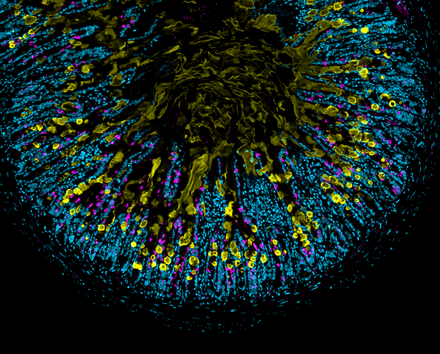An inflammation and a rise in mucus production are typical signs of allergies and worm infections. The innate immune cells are involved in this immunological response, although it is still unclear exactly what they do.
 The effect of ILC2 in worm infections: Cross-section through the small intestine after infection with the roundworm Nippostrongylus brasiliensis. Goblet cells in the intestine produce increased amounts of mucus (yellow) to flush out the worm. Mucus production is triggered by the type 2 immune response, which involves not only ILC2 (not stained) but also tuft cells (magenta). The latter are located in the intestinal villi, the finger-like protrusions of the intestinal mucosa that extend into the intestinal cavity (nuclei of the mucosal cells in turquoise). Image Credit: Charité | Patrycja Topczewska
The effect of ILC2 in worm infections: Cross-section through the small intestine after infection with the roundworm Nippostrongylus brasiliensis. Goblet cells in the intestine produce increased amounts of mucus (yellow) to flush out the worm. Mucus production is triggered by the type 2 immune response, which involves not only ILC2 (not stained) but also tuft cells (magenta). The latter are located in the intestinal villi, the finger-like protrusions of the intestinal mucosa that extend into the intestinal cavity (nuclei of the mucosal cells in turquoise). Image Credit: Charité | Patrycja Topczewska
Now, Charité-Universitätsmedizin Berlin researchers have clarified the primary functions that these cells carry out. Researchers also identified prospective therapeutic modalities for the treatment of allergies in the study, which was published in the journal Nature.
The adaptive immune system, which picks up new skills with every infection and continuously improves over the course of a lifetime, and the innate immune system, which is less specialized but responds especially quickly and effectively, are the two interconnected branches that make up the human immune system.
The innate immune system’s cells are found in the mucous membranes of the intestinal and respiratory tract, where they serve as the first line of defense against pathogens as they enter the body.
Group 2 innate lymphoid cells, also known as ILC2s, are among these cells and are active in the intestine in cases of parasite diseases and the respiratory tract in cases of allergies.
Innate lymphoid cells were discovered a decade or so ago and we already know a lot about them, but their exact function in the machinery of the immune system is not yet completely understood.”
Dr Christoph Klose, Institute of Microbiology, Infectious Diseases and Immunology, Charité-Universitätsmedizin Berlin
Dr Klose is also the head of the Emmy Noether Independent Junior Research Group at the Institute of Microbiology, Infectious Diseases, and Immunology of Charité, which studies how neuropeptides and neurotransmitters control type 2 immune responses.
He added, “There is a group of adaptive immune cells—namely the T cells—that carry out some similar functions as part of the type 2 immune response, so it was previously thought that the role of ILC2s may be redundant and could be easily taken over by the T cells.”
The recently released study, however, has now shown this theory to be inaccurate. They have clarified the primary roles of ILC2s using an animal model and advanced molecular techniques like single-cell sequencing, which enables researchers to zoom into individual cells and examine their molecular state.
“A certain type of immune cells called eosinophils were not able to develop properly when ILC2s were absent. This relationship was previously unknown and came as a big surprise,” further added Dr Klose.
Inflammatory processes in the tissue are mediated by eosinophils. Furthermore, the researchers discovered that ILC2s had a significant impact on epithelial cells’ capacity to encourage the creation of mucus and remove parasites like worms from the body.
Dr Klose stated the while summarizing the study’s findings, “The absence of ILC2s was clearly noticeable in our tests examining the immune response to worm infections. There was only limited mucus production in the tissue and the parasites could no longer be combated effectively.”
In other experiments, the scientists looked at allergic asthma symptoms and discovered that these were enhanced in the absence of ILC2s.
Dr Klose stated, “This could be a starting point for future studies aimed at developing potential allergy therapies. With our study, we were able to show that group 2 innate lymphoid cells are essential cogs in the machinery of the immune system and cannot be replaced without compromising the immune response.”
Dr Klose and his team plan to explore whether additional components of the immune response are regulated by innate lymphoid cells in future studies.
Source:
Journal reference:
Jarick, K. J., et al. (2022). Non-redundant functions of group 2 innate lymphoid cells. Nature. doi.org/10.1038/s41586-022-05395-5